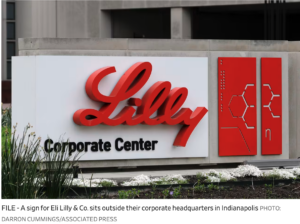
Nearly seven million Americans are living with Alzheimer’s Disease. Approximately one in three seniors dies with Alzheimer’s or another dementia. It kills more than breast cancer and prostate cancer combined. Over eleven million Americans provide unpaid care for people with Alzheimer’s or other dementias. In 2024, Alzheimer’s and other dementias will cost the nation $360 billion. By 2050, these costs could rise to nearly $1 Trillion. These are just some of the alarming statistics about this disease from the Alzheimer’s Association website.
With that background, the good news is there is progress in developing new medicines to treat this dreaded disease. The editorial board of The Wall Street Journal tells us a Food and Drug Administration advisory committee just unanimously recommended approval of a new Alzheimer’s disease treatment called donanemab, manufactured by Eli Lilly Pharmaceuticals.
Lilly has spent more than 30 years and $8 billion working on Alzheimer’s treatments. Four clinical trials with another experimental drug had failed. After one pivotal trial in 2016 disappointed, some dismissed Lilly’s strategy of targeting amyloid plaque in the brain—a signature of the disease—and urged the company to abandon its Alzheimer’s drug research.
Instead, Lilly learned from earlier trials and made a major bet on donanemab, another anti-amyloid drug. Some patients in earlier trials suffered from other forms of dementia. Advances in brain imaging enabled Lilly to accurately diagnose and screen Alzheimer’s patients for its donanemab trial. Lilly also used brain scans to track disease progression.
Donanemab clears amyloid that had built up over decades and slows decline by an average of 35% over 18 months. While such benefits are modest, the drug can extend patients’ ability to function independently by months and, possibly, years. Patients also get precious more time with loved ones.
Catching and treating Alzheimer’s early, as with many diseases, improves the prognosis. Patients in earlier stages of the disease notably showed greater benefits from the drug. Nearly half experienced no decline after one year. Among those in the earliest stage, donanemab slowed decline on average by 60%.
Donanemab’s benefits continued even after patients stopped taking the monthly infusions. Nobody wants to be on a drug for the rest of their lives, especially one that carries a small risk of brain bleeding that must be continuously monitored. The FDA panel unanimously agreed that donanemab’s benefits exceed the risks.
Scientists disagree about Alzheimer’s causes, but many believe that amyloid drives a degenerative neurological cascade, which results in brain inflammation and neuron death. Amyloid develops decades before patients show cognitive symptoms. Donanemab is the third drug to show that removing amyloid early in the disease can slow decline.
If approved, donanemab will compete with the anti-amyloid lecanemab by Biogen and Eisai, which showed somewhat fewer side effects in trials. Donanemab requires an infusion only once a month compared to twice for lecanemab. Patients can weigh the risks against the benefits with their doctors and caregivers.
Meantime, artificial intelligence is accelerating the development of blood tests that can diagnose Alzheimer’s and predict it years before patients show cognitive problems. This holds the promise that anti-amyloid treatments might soon be used for prevention, as statins are for heart disease.
After Lilly’s major trial ended in failure eight years ago, many scientists declared Alzheimer’s untreatable. They were wrong. Lilly shows that perseverance can pay off. Let’s hope others will follow their lead and continue the fight to treat this dreaded disease that affects so many of our elderly citizens.

